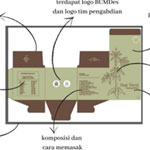Inovasi Kemasan Nasi Tiwul untuk Membantu Perekonomian Masyarakat Dusun Sendang Bedog
DOI:
https://doi.org/10.14421/jbs.3433Keywords:
DESIGN, PACKAGING, processed productsAbstract
Produk nasi tiwul dari dusun Sendang Bedog yang ada di Desa Samar masih kurang menarik kemasanya. Kurangnya pengetahuan tentang kemasan produk yang baik menyebabkan produk Tiwul masih rendah penjualannya. Tujuan pengabdian ini untuk membangun presepsi masyarakat kepada produk olahan tiwul yang dijual. Metode yang digunakan dalam pengabdian ini meliputi perencanaan, pelaksanaa, dan evaluasi produk. Pengukuran keberhasilan program dilihat dari tingkat penjualan produk tersebut. Hasil dari pengabdian ini yaitu kemasan dari produk nasi tiwul menjadi lebih menarik dan berdampak pada kenaikan penjualan produk tersebut sebesar tiga persen yaitu dari seratus menjadi seratus tiga.
[Tiwul rice products from the Sendang Bedog hamlet in Samar Village are still less attractive in packaging. Lack of knowledge about good product packaging causes Tiwul products to still have low sales. The purpose of this service is to build public perception of the processed tiwul products that are sold. The methods used in this service include planning, implementing, and evaluating products. The measurement of the success of the program is seen from the level of product sales. The result of this service is that the packaging of nasi tiwul products becomes more attractive and has an impact on increasing sales of these products by three percent, from one hundred to one hundred and three.]
References
Agustina, W. (n.d.). TEKNOLOGI PENGEMASAN, DESAIN DAN PELABELAN KEMASAN PRODUK MAKANAN. 8.
Anwari, E., Meilani, E., & Prasetyowati, O. (2018). PERANCANGAN GRAFIS KEMASAN MAKANAN BURAYOT SEBAGAI OLEH-OLEH KHAS GARUT. DeKaVe, 10(2), 12–24. https://doi.org/10.24821/dkv.v10i2.1990
Erlyana, Y. (2018). ANALISIS PERANAN DESAIN KEMASAN TERHADAP BRAND IDENTITY DARI SEBUAH PRODUK MAKANAN LOKAL INDONESIA DENGAN STUDI KASUS: PRODUK OLEH-OLEH KHAS BETAWI ‘MPO ROMLAH.’ National Conference of Creative Industry. https://doi.org/10.30813/ncci.v0i0.1316
Hanifawati, T., Suryantini, A., & Mulyo, J. H. (n.d.). Universitas Gadjah Mada trihanifawati@gmail.com any.suryantini@ugm.ac.id jhandoyom@ugm.ac.id. 11.
Hanifawati, T., Suryantini, A., & Mulyo, J. H. (2017). PENGARUH ATRIBUT KEMASAN MAKANAN DAN KARAKTERISTIK KONSUMEN TERHADAP PEMBELIAN. Agriekonomika, 6(1). https://doi.org/10.21107/agriekonomika.v6i1.1895
Ilmiawati, C., Reza, M., Rahmatini, R., & Rustam, E. (2017). Edukasi Pemakaian Plastik sebagai Kemasan Makanan dan Minuman Serta Risikonya terhadap Kesehatan pada Komunitas di Kecamatan Bungus Teluk Kabung, Padang. LOGISTA - Jurnal Ilmiah Pengabdian kepada Masyarakat, 1(1), 20. https://doi.org/10.25077/logista.1.1.20-28.2017
Kartajaya, H. (n.d.). 5. FAKTOR-FAKTOR DESAIN KEMASAN. 6.
Mukhtar, S., & Nurif, M. (2015). PERANAN PACKAGING DALAM MENINGKATKAN HASIL PRODUKSI TERHADAP KONSUMEN. Jurnal Sosial Humaniora, 8(2), 181. https://doi.org/10.12962/j24433527.v8i2.1251
Praswati, A. N. (n.d.). DESAIN KEMASAN MAKANAN KUB SUKARASA DI DESA WISATA ORGANIK SUKOREJO SRAGEN. 19, 8.
Ramadlon, S. (2016). PERANCANGAN DESAIN KEMASAN MAKANAN RINGAN PRODUKSI KARANG TARUNA JIWO SUTO UJUNGPANGKAH GRESIK. 04, 8.
Susanti, E., Sari, N., & Amri, K. (2018). Pengaruh Labelisasi Halal Terhadap Keputusan Pembelian Makanan Kemasan (Studi Kasus Pada Mahasiswa Fakultas Ekonomi Dan Bisnis Islam). 2(1), 7.
Syahputra, A., & Hamoraon, H. D. (n.d.). PENGARUH LABELISASI HALAL TERHADAP KEPUTUSAN MASYARAKAT KECAMATAN PERBAUNGAN DALAM PEMBELIAN PRODUK MAKANAN DALAM KEMASAN. 13.
Tunky, H., & Kohardinata, C. (n.d.). PERANCANGAN DESAIN KEMASAN PADA MERK KERIPIK PISANG BANANATION DI SURABAYA. 1, 8.
Wahmuda, F. (2018). MAKNA TAMPILAN VISUAL KEMASAN SEBAGAI PENERAPAN REDESAIN KEMASAN MAKANAN RINGAN DI UKM BENOK – KABUPATEN PROBOLINGGO. 6.
Zen, Z. H., Satriardi, S., Dermawan, D., Anggraini, D. A., Meirizha, St. N., & Yul, F. A. (2017). PELATIHAN DESAIN KEMASAN PRODUK UMKM DI KECAMATAN TAMBANG, KABUPATEN KAMPAR. Jurnal Pengabdian UntukMu NegeRI, 1(2), 12–15. https://doi.org/10.37859/jpumri.v1i2.225

Downloads
Published
How to Cite
Issue
Section
License
Copyright (c) 2022 Slamet Fauzan, Juniesha Tanaya Putri; Immatus Sima Ar Rokhman; Nadila Sherine Febrianti, Iqbal Herdiansyah

This work is licensed under a Creative Commons Attribution-NonCommercial-ShareAlike 4.0 International License.
Authors who publish with this journal agree to the following terms:
- Authors retain copyright and grant the journal right of first publication with the work simultaneously licensed under a Creative Commons Attribution-NonCommercial-ShareAlike 4.0 International (CC BY-NC-SA 4.0) that allows others to share the work with an acknowledgement of the work's authorship and initial publication in this journal.
- Authors are able to enter into separate, additional contractual arrangements for the non-exclusive distribution of the journal's published version of the work (e.g., post it to an institutional repository or publish it in a book), with an acknowledgement of its initial publication in this journal.
- Authors are permitted and encouraged to post their work online (e.g., in institutional repositories or on their website) prior to and during the submission process, as it can lead to productive exchanges, as well as earlier and greater citation of published work.





